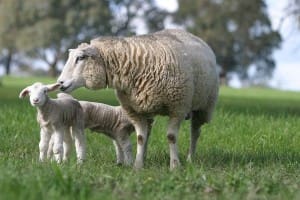 Low worm-risk paddocks for weaners and lambing ewes can help lift production, cut drench costs and slow resistance, according to ParaBoss operations manager Deb Maxwell.
Low worm-risk paddocks for weaners and lambing ewes can help lift production, cut drench costs and slow resistance, according to ParaBoss operations manager Deb Maxwell.
Ms Maxwell said she found low worm-risk paddocks had a major positive impact on worm control on her sheep property near Guyra, northern NSW, “where barber’s pole worm reigns supreme”.
She has been able to drop three or four drenches a year and the paddock preparation was very easy to do.
Maiden ewes and ewes with multiple lambs can benefit most
Weaners, at and in the weeks after weaning, are susceptible because they have an immature immune response to worms, suffer the stress of separation from their mother, and generally face either high summer worm burdens in the north or hot, dry summers with lower nutrition in the south, she said.
“In southern Australia, winter weaners are very susceptible after the break of the season, when they may be in light condition and are normally faced with a large winter worm challenge.
“Lambing ewes are highly susceptible to worms as their natural immunity drops considerably around lambing time and into lactation,” Ms Maxwell said.
“This is typically worse for maiden ewes and ewes rearing multiple lambs.”
Low worm-risk paddocks allow for flexibility in drench use
Ms Maxwell said sheep on a low worm-risk paddock will face a lower worm challenge, allowing for higher milk production and lamb growth and the flexibility to use short-acting drenches, rather than an annual reliance on a long-acting combination as a pre-lambing treatment.
“The benefits of this are also felt as better management to slow drench resistance,” she said.
“Secondly, with a lower worm burden than if they were on unprepared pastures, these more susceptible animals won’t be adding the large level of worm contamination to the paddock that they otherwise would have.
“This greatly reduces the build-up of worms over the season that contributes to later problems and the need for more drenching.”
Prepare paddocks to kill worm eggs and larvae
Ms Maxwell said preparation involves identifying the weaning or lambing paddocks in advance, then using them in a way that prevents further contamination with worm eggs for 3-6 months before weaning, lambing or for winter weaners.
“During this time, you are aiming to have over 90 percent of the worm eggs and larvae already on the pasture die, and with no further contamination, a low worm-risk paddock is produced.
“Paddocks don’t have to stay empty!”
She said cattle, or even sheep — for a period of time after an effective short-acting treatment or a longer period after an effective long-acting treatment — can graze them, and in some locations or times (very hot and dry or very cold), even wormy sheep can be grazed there.
“They can be used for crops or hay or spelled for a few weeks to allow new growth.
“If you have multiple lambing and weaning paddocks, don’t be overwhelmed – just try one paddock for one group next year and see how it compares,” she said.
Ms Maxwell said the time of year, duration of preparation and sheep destined to use these paddocks varies according to region. Your Program in WormBoss describes what to do to prepare low worm-risk paddocks.
The WormBoss Management Tools section also has a more detailed article on using grazing management to prepare low worm-risk paddocks.
Source: ParaBoss

HAVE YOUR SAY